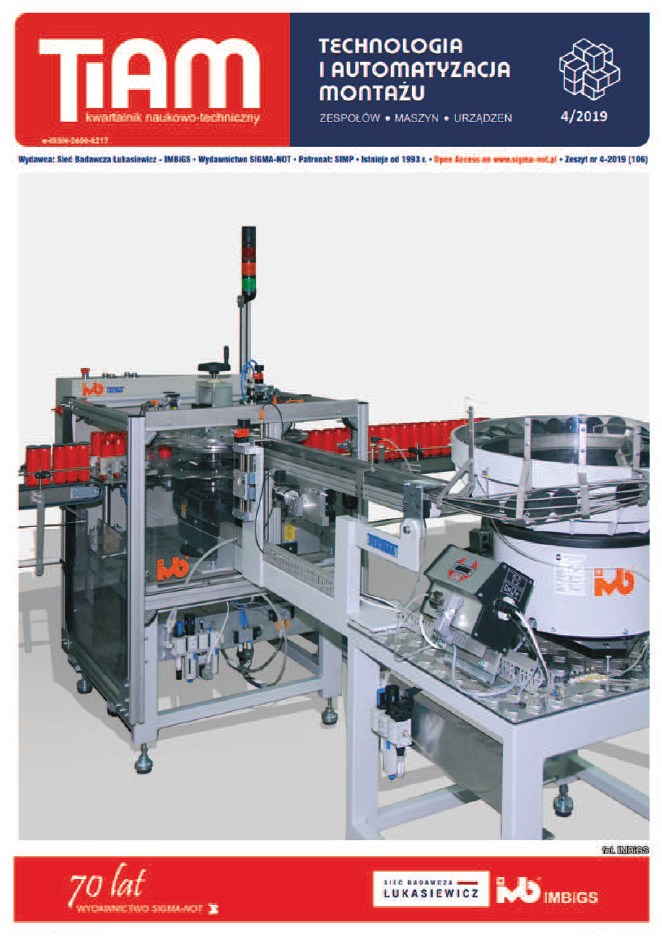Abstract
The article describes the shear strength and statistical analysis of adhesive joints of four polymers used in the automotive industry, i.e. polypropylene, polystyrene, polyamide and polyacetal. Adhesive joints were prepared using two types of epoxy adhesive: Epidian 57/1DAl1 00:50 and Epidian 6ITFF/100:27. Surfaces of bonded materials prior to the bonding process were prepared using sandpaper P120, and then to remove impurities formed after mechanical treatment, the surface of polymer materials was degreased with acetone. The adhesive joints after the curing process were subjected to a strength test on the Zwick/ Roell 150 strength machine in accordance with the PN-EN 1465 standard. The STATISTICA program was used for statistical analysis of the results of the strength tests. Parameters of descriptive statistics were determined, normality of distribution was determined and statistical tests of strength parameters were carried out. It was noted, among other things, that the greatest shear strength was obtained by adhesive joints of HIPS 425N polystyrene bonded Epidian 6/1DAl100:50 epoxy adhesive. However, the smallest shear strength was characterized by the adhesive joints made of Tarnamid T-27 polyamide bonded with Epidian 61 TFF/1 00:27 adhesive, which amounted to about 30 of the highest strength value obtained.
This is an Open Access article distributed under the terms of the Creative Commons Attribution License CC BY 4.0 (https://creativecommons.org/licenses/by/4.0/)
References
Rozporządzenie komisji UE nr 459/2012
Patil A, A Patel, R. Purohit. 2017. "An overview of Polymeric Materials for Automotive Applications". Materials Today: Proceedings (4): 3807-3815.
https://pl.pinterest.com/pin/549228117031062526/ , dostęp 10.02.2019.
Adams R.D., J. Comyn, W.C. Wake. 1997. "Structural Adhesive Joints in Engineering Book". 2nd edition, Springer, United Kingdom.
Kasperek D., A Rudawska. 2017. .Zastosowanie klejenia w budowie autobusów". Technologia i Automatyzacja Montażu (4): 42-46.
Godzimirski J. i in. 1997. Konstrukcyine polaczenia klejowe elementów metalowych w budowie maszyn". Oficyna Wydawnicza Politechniki Rzeszowskiej.
Rudawska A. 2017. .Przygotowanie powierzchni do klejenia wybranych materiałów konstrukcyjnych". Wydawnictwo Politechniki Lubelskiej.
Szlezyngier w., Z. Brzozowski. 2012. .Tworzywa sztuczne polimery specjalne i inżynieryjne". Rzeszów: Wydawnictwo Fosze.
Ashcroft lA, J. Comyn, S. Tellwright. 2009. "Adhesives for automotive windscreen replacement: Kinetics of cure and bond strength". International Journal of Adhesion and Adhesives (29): 155-166.
Kasperek D., A. Rudawska. 2018. "Wybrane aspekty montażu autobus6w z wykorzystaniem technologii klejenia". Technologia i Automatyzacja Montażu (1): 20-25.
Rudawska A. 2013. "Wybrane zagadnienia konstruowania polaczeń adhezyjnych jednorodnych i hybrydowych". Wydawnictwo Politechniki Lubelskiej.
Rabiej M. 2018. .Analizy statystyczne z programami Statistica i Excel". Gliwice: Wydawnictwo Helion.
Sobczyk M. 1997. "Statystyka". Warszawa: Wydawnictwo Naukowe PWN.
Miturska I., A. Rudawska. 2016. "Statystyczna interpretacja wyników pomiarów wytrzymałości połączeń adhezyjnych wybranych materiałów konstrukcyjnych", Mechanik (11): 1620-1623.
PN-EN 1465. Oznaczanie wytrzymałości na ścinanie przy rozciąganiu polaczeń na zakładkę,


